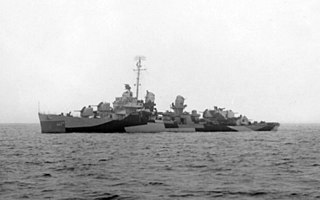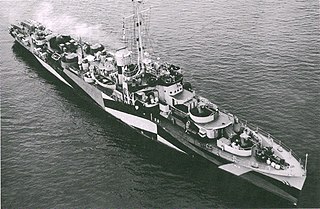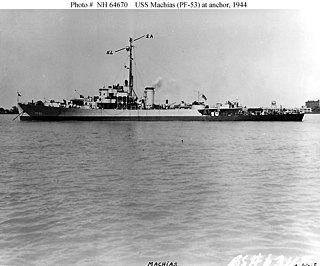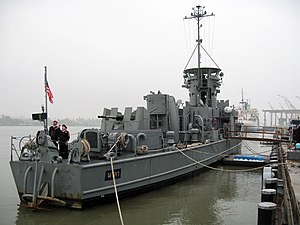The names of commissioned ships of the United States Navy all start with USS, for United States Ship. Non-commissioned, primarily civilian-crewed vessels of the U.S. Navy under the Military Sealift Command have names that begin with USNS, standing for United States Naval Ship. A letter-based hull classification symbol is used to designate a vessel's type. The names of ships are selected by the Secretary of the Navy. The names are those of states, cities, towns, important persons, important locations, famous battles, fish, and ideals. Usually, different types of ships have names originated from different types of sources.

The Landing Craft, Support (Large) were two distinct classes of amphibious warfare vessels used by the United States Navy (USN) in the Pacific and the Royal Navy in World War II. The USN versions, which were later reclassified Landing Ship Support, Large, also performed radar picket duty and fire fighting.

USS Heywood L. Edwards (DD-663) was a Fletcher-class destroyer of the United States Navy, named after Lieutenant Commander Heywood L. Edwards (1905–1941), captain of the destroyer USS Reuben James, the first U.S. Navy ship sunk in World War II. Following the war, the ship was transferred to Japan and renamed Ariake. The ship served with the Japanese until 1974 and was scrapped in 1976.

USS Richard P. Leary (DD-664) was a Fletcher-class destroyer of the United States Navy. In 1959, the ship was transferred to the Japanese Maritime Self-Defense Force and renamed Yūgure. The destroyer remained in service with the Japanese until 1974, when she was returned to the US, who then sold the ship for scrap in 1976.

USS Allentown (PF-52), a United States Navy Tacoma-class frigate in commission from 1944 to 1945, has thus far been the only U.S. Navy ship to be named for Allentown, Pennsylvania. She later served in the Soviet Navy as EK-9 and in the Japan Maritime Self-Defense Force as JDS Ume (PF-9), JDS Ume (PF-289) and as YAC-14.

USS Albuquerque (PG-115/PF-7), a Tacoma-class patrol frigate in commission from 1943 to 1945 and from 1950 to 1953, was the first ship of the United States Navy to be named for Albuquerque, New Mexico. She also served in the Soviet Navy as EK-14 and in the Japan Maritime Self-Defense Force as JDS Tochi (PF-16/PF-296) and as YAC-15.

USS Pasco (PG-114/PF-6), a Tacoma-class patrol frigate in commission from 1944 to 1945, has thus far been the only ship of the United States Navy to be named for Pasco, Washington. She later served in the Soviet Navy as EK-12 and in the Japan Maritime Self-Defense Force as JDS Kashi (PF-3/PF-283) and as YAC-12.

USS Everett (PG-116/PF-8), a Tacoma-class patrol frigate in commission from 1944 to 1945 and from 1950 to 1953, thus far has been the only ship of the United States Navy to be named for Everett, Washington. She also served in the Soviet Navy as EK-15 and in the Japan Maritime Self-Defense Force as JDS Kiri (PF-11/PF-291/YAC-20).

USS Charlottesville (PF-25), a United States Navy Tacoma-class frigate in commission from 1944 to 1945, has been the only US Navy ship thus far to be named for Charlottesville, Virginia. She later served in the Soviet Navy as EK-1 and in the Japan Maritime Self-Defense Force as JDS Matsu (PF-6), JDS Matsu (PF-286) and YAS-36.
USS Newport (PF-27), a Tacoma-class frigate in commission from 1944 to 1945, and from 1950 to 1952, was the second ship of the United States Navy to be named for the city of Newport, Rhode Island. She later served in the Soviet Navy as EK-28 and in the Japan Maritime Self-Defense Force as JDS Kaede (PF-13), JDS Kaede (PF-293) and as YAC-17.

The second USS Gallup (PF-47), a Tacoma-class frigate in commission from 1944 to 1945 and from 1950 to 1951, was the first ship of the United States Navy to be named for Gallup, New Mexico. She also served in the Soviet Navy as EK-22 and in the Royal Thai Navy as HTMS Prasae.

The Shinyo were Japanese suicide motorboats developed during World War II. They were part of the wider Japanese Special Attack Units program.

The Landing Craft Infantry (LCI) were several classes of landing craft used by the Allies to land large numbers of infantry directly onto beaches during World War II. They were developed in response to a British request for seagoing amphibious assault ships capable of carrying and landing substantially more troops than their smaller Landing Craft Assault (LCA). The result was a small steel ship that could land 200 men, traveling from rear bases on its own bottom at a speed of up to 15 knots.

USS Carson City (PF-50), a Tacoma-class frigate in commission from 1944 to 1945, thus far has been the only ship of the United States Navy to be named for Carson City, Nevada. She later served in the Soviet Navy as EK-20 and in the Japan Maritime Self-Defense Force as JDS Sakura (PF-10), JDS Sakura (PF-290) and as YAC-16.

USS LST-31 was a United States Navy LST-1-class tank landing ship used exclusively in the Asiatic-Pacific Theater during World War II. Like many of her class, she was not originally named and is properly referred to by her hull designation. Later she was named for Addison County, Vermont. She was the only US Naval vessel to bear the name.

USS Krishna (ARL-38) was one of 39 Achelous-class landing craft repair ships built for the United States Navy during World War II. Named for Krishna, she was the only U.S. Naval vessel to bear the name, and only one of three ships to be named after a Hindu deity.

The second USS Machias (PF-53) was a United States Navy Tacoma-class frigate in commission from 1944 to 1945 which later served in the Soviet Navy as EK-4 and the Japan Maritime Self-Defense Force as JDS Nara (PF-2), JDS Nara (PF-282) and YTE-8.
The second USS Bath (PF-55) was a United States Navy Tacoma-class frigate in commission from 1944 to 1945 which later served in the Soviet Navy as EK-29 and the Japanese Maritime Self-Defense Force, with her Japanese name reported by various sources as JDS Maki (PF-18) and JDS Maki (PF-298), and later as YTE-9.















